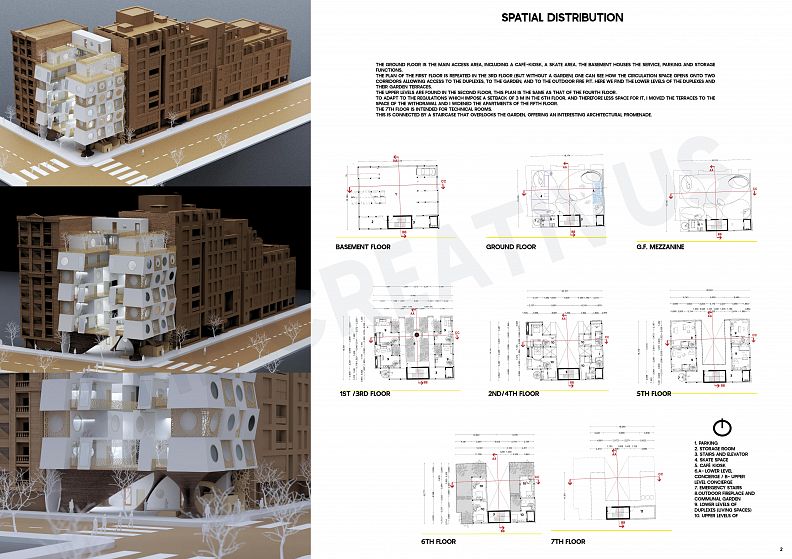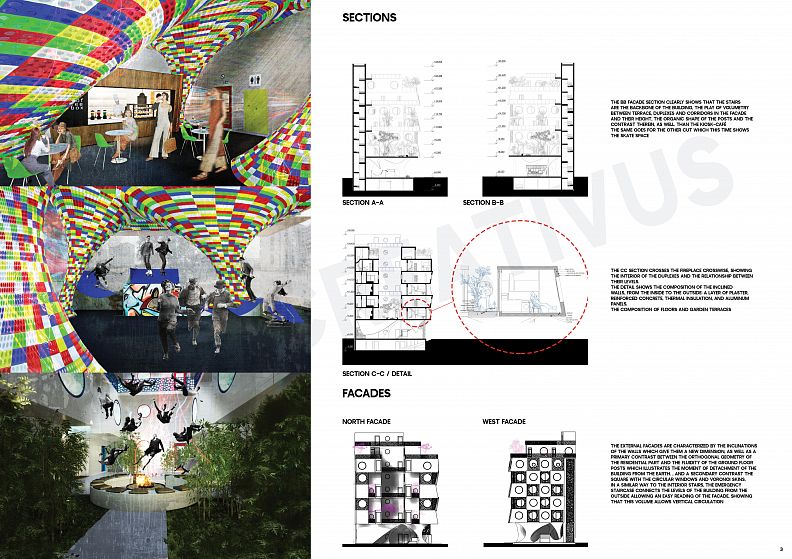LEGO Housing

Project idea
This project is a response to a specific Moroccan housing problem, that of the difficulty young people find when looking for housing, often families with children refuse to move in with them.
which makes it difficult for them to be independent and earn a living, especially with the digital age of Freelancers, YouTubers, etc. ..., we find that more young Moroccans prefer to work from home
Adding to this problem that of sustainability, the lack of green space in our buildings, which means that the word affordable rarely goes hand in hand with that of quality.
Project description
My concept has developed through multiple challenges, the first being that of the regulation which imposes the subtraction of the courtyard part, the addition of cantilevers (1.5), taking into account the maximum heights of the levels. then I had to divide the key elements of my program, first in horizontal volumes in red: habitat; in green (ground floor): public; in blue (basement): services. interconnected by a vertical volume (the yellow one) serving for vertical circulation. Afterwards, I opted for a free ground floor, by raising the first floor on stilts, this free space would be an intersection between public and domestic, a square for the community that can help integrate our building and its inhabitants into the neighbourhood by housing entertainment functions, including a skate area and a Café-box.
I chose to adopt SEMPER's theory, that of the “four elements of architecture”, the first being the hearth: in this project, the external fireplace which centralizes the common garden on the 1st floor, the result of the H /D of the courtyard, it is a space for socializing which also offers a beautiful view from the windows overlooking the courtyard. The second is carpentry, here the use of a grid that orders the structural elements and regulates the housing units. The third is enclosure: aluminium panels, Lego cladding and Voronoi skins. The fourth being the Base: Ground floor posts.
Since the site is blocked by the south and the east, there will be little sunshine inside, adding to this the area of the site is 291 m² with the 76 m² that the yard must take, this does not leave any space for dwelling units, two or three maximum per floor. For these reasons I opted to work in verticality, therefore duplexes using a frame that ensures a quality of surface between them, with standard dimensions in order to create a more functional space, I associated a garden terrace of 6 m of height for each unit, it will allow the entry of daylight to the different spaces of the unit, especially for the units which are on the east side of the courtyard, and natural ventilation.
Knowing that we are limited to R + 5, with a minimum ceiling height of 3m we opted for a circulation whose corridors are repeated every two levels to access the lower level of the duplex and allow the upper one to stretch out above thus gaining more space.
For the units themselves, the plan differs with respect to its location in the building and the optimization of space in it, while maintaining equity among residents.
for Plans, The ground floor is the main access area, including a café-kiosk, a skate area. The basement houses the service, parking and storage functions.
The plan of the first floor is repeated in the 3rd floor (but without a garden) one can see how the circulation space opens onto two corridors allowing access to the duplexes, to the garden, and to the outdoor fire pit. Here we find the lower levels of the duplexes and their garden terraces.
The upper levels are found on the second floor, this plan is the same as that of the fourth floor.
To adapt to the regulations which impose a setback of 3 m on the 6th floor, and therefore less space for it, I moved the terraces to the space of the withdrawal and I widened the apartments of the fifth floor.
The 7th floor is intended for technical rooms.
This is connected by a staircase that overlooks the garden, offering an interesting architectural promenade.
As for the sections, they clearly show that the stairs are the backbone of the Building, the play of volumetry between the Terrace, duplexes and corridors in the facade and their height, the organic shape of the posts and the contrast therein, as well as the kiosk-café. The same goes for the other cut which this time shows the skate space.
The CC section crosses the fireplace crosswise, showing the interior of the duplexes and the relationship between their levels. The detail shows the composition of the inclined walls, from the inside to the outside: a layer of plaster, reinforced concrete, thermal insulation, and aluminium panels. As well as the composition of floors and garden terraces.
The external facades are characterized by the inclinations of the walls which give them a new dimension, as well as a primary contrast between the orthogonal geometry of the residential part and the fluidity of the ground floor posts which illustrates the moment of the detachment of the building from the earth. and a secondary contrast the square with the circular windows and Voronoi skins.
In a similar way to the interior stairs, the emergency staircase connects the levels of the building from the outside, allowing easy reading of the facade, as the volume allows vertical circulation.
Technical information
For structure, shear walls were used for the Inclined walls, the offset of the posts will be compensated by brackets (consoles) which will transmit the vertical loads to the posts of the lower storey and so on.
The materials chosen are:
• Aluminum panels for the external cladding, this material which is characterized by a light reflection index, which will optimize the space, the sunshine inside the courtyard and will give a luminous aesthetic to the building.
• Lego coatings for the posts as a clue to the play function it houses, the youth of the building and to attract people, the main colours were also reused in the Voronoi skins to harmonize the exterior treatment.




